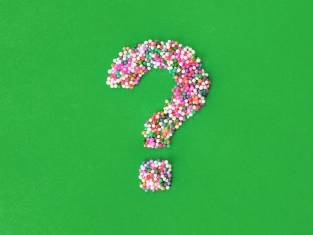by PushtoLearn
Question Mark
Table of Contents
Questions Exercises
These exercises focus on different types of questions.
What a Question Mark Does
A question mark ends a direct question - whether the question is open (“What time is it?”) or closed (“Are you ready?”). It replaces a period and never appears together with one.
Indirect questions are statements, so they take a period: She asked why the report was late.

Core Rules of Placement
Stand-alone questions
Put the mark at the very end of the clause: Why do they make so many mistakes?
Quotation marks (AmE vs. BrE)
-
If the quoted words are the question, the mark stays inside: He asked, “Where are you?”
-
If only the framing sentence is the question, it sits outside: Did she really say “I quit”?
Parentheses and brackets
The mark goes inside if the whole parenthetical is a question: They decided (and why wouldn’t they?) to leave. It stays outside when the question applies to the full sentence: Is this proposal cost-effective (given the new data)?
Tag questions
Add the mark after the tag: You’re joining us, aren’t you?
Requests that masquerade as questions
Polite imperatives such as “Would you please pass the salt.” may take a period in formal copy because they function as commands, not real questions, though a mark is never wrong.
Special Uses and Edge Cases
Rhetorical questions
Most style guides keep the question mark: Who knew? But Chicago notes that a period (or even an exclamation point) can convey a deliberately flat or emphatic tone.
Interrobang (‽) or “?!”
Chicago advises choosing one mark - usually “!” for a rhetorical exclamation - and avoiding the doubled “?!” except in very informal contexts.
Uncertainty or doubtful data
A lone mark in parentheses or brackets shows uncertainty in scholarly dates: Mozart (1756 – 1791?) composed more than 600 works. Style manuals for history and genealogy accept this shorthand.
Multiple questions in one sentence
Either use one mark at the end - Where, when, and why did it happen? - or break the sentence apart for clarity.
Question Marks in Titles and Headings
AP and Chicago both keep question marks in headlines if the title is itself a direct question: “Should You Buy an EV Now?” The mark does not disqualify the sentence from headline-style capitalization.
Common Mistakes to Avoid
|
Mistake |
Why it’s wrong |
Fix |
|
Adding a question mark to an indirect question |
It’s a statement, not a query |
She wondered where he was. |
|
Using “?!” in formal writing |
Seen as informal/shouty |
Choose one mark, usually “!” |
|
Combining a question mark with a period |
The mark already ends the sentence |
Drop the period |
FAQs
When should I use a question mark instead of a period?
Use a question mark only after a direct question; use a period after statements and indirect questions.
Does the question mark go inside or outside quotation marks?
Place it inside if the quoted words are the question; otherwise keep it outside.
What punctuation ends a rhetorical question?
Most writers keep the question mark, but a period or exclamation point can convey irony or emphasis in rhetorical contexts.
Can I use a question mark to show uncertainty in dates?
Yes, insert a parenthetical question mark after the doubtful year: (1874?–1930).
Is “?!” acceptable in professional writing?
Formal guides recommend choosing either “?” or “!”; reserve “?!” for highly informal or creative copy.

